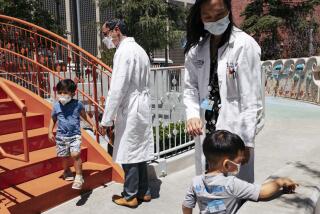Allergies Pose Challenge for Clinton Health Plan
- Share via
Amy Bentsen was only six months old when she started to suffer chronic ear infections that required near-constant use of antibiotics. Her mother, Elesa, suspected that allergies were the cause of Amy’s ailments, because serious allergy problems ran in the family. But the pediatrician told Elesa not to worry. As long as antibiotics could clear Amy’s ears, allergy testing wouldn’t be necessary, he says.
“In 11 months, I was in the doctor’s office 20 times. I spent $1,209 on office visits and $720 on prescription medicines,” the Atlanta-based homemaker complains. Worse still, Amy wasn’t getting any better.
Now, six years later, Amy is a healthy 10-year-old who rarely visits the doctor. Notably, her miracle cure was as inexpensive as it was effective. Her mother changed her diet.
At a time when the nation is grappling with soaring medical expenses and a sweeping medical reform proposal, children like Amy pose both challenge and opportunity for the health care industry and the federal government.
As Amy illustrates, the best way to manage medical expenses is to keep people healthy. But, despite immunizations and platitudes to the contrary, modern medicine concentrates on treating diseases--not preventing them. And doctors are deeply divided on the question of whether President Clinton’s health proposal will exacerbate or alleviate that problem.
The Clinton plan does stress preventive care. But it also gives additional responsibilities to primary care doctors, such as pediatricians and general practitioners. Some of these doctors fear that this combination will spell less time per patient. And that works against preventive care, which is most effective when doctors and patients have time to talk.
And nowhere is that thoughtful doctor-patient relationship more important than when a child has allergies, doctors say. Pediatric allergies, which are often chronic but rarely fatal, can also be more costly than nearly any other nonfatal disease.
Allergic children often end up in doctor’s offices every month with ailments that range from ear, sinus and throat infections to skin diseases. Many use costly antibiotics virtually every day of their lives, either to prevent or treat an allergic ailment, doctors say. In short, spending upward of $1,000 per year on an allergic child is commonplace.
Allergies are common also. Recent studies indicate that one in every four adults will suffer some allergic ailment during their lives. Some pediatricians estimate that allergic children could account for roughly one-quarter of all pediatric ailments that require doctor’s visits too.
Children who suffer nagging ear infections, skin or respiratory problems are particularly likely to have allergies, says Dr. Leo Galland, a New York-based specialist and author of “Superimmunity for Kids,” a book about allergies and diet.
The good news is that parents can significantly cut their children’s ailments--and medical expenses--by becoming educated about allergies, doctors say. And parents underscore the point.
Lori Schneider, a Los Angeles-area mother of four, thought her son, Richard, might need a nose operation to clear his constant congestion, for example. However, when she discovered that he was allergic to a number of foods, plants, molds and animal dander, she put the dogs and cats outside and drastically changed his diet. Now, Richard’s breathing is normal. But if the animals sleep in his room or his diet is broken, Lori says she sees a notable change.
“If I wasn’t keeping track of (allergies), I might think he was coming down with something,” she says. “But that’s not it. He’s just having an allergic reaction.”
Several other parents maintain they’ve seen marked improvement in everything from ear infections to dry skin when they start monitoring exposure to allergens, such as animal fur, dust and foods.
The bad news is that tracking allergies is hard work. In some cases, it requires keeping a daily diary of every morsel that gets into a child’s mouth. And that’s hard to do, particularly once kids are old enough to open the refrigerator. Concerned parents also need to keep closer track of vitamins when they eliminate a suspected food. Allergies can be serious, and so can vitamin deficiencies.
Food allergy avoidance also involves a certain amount of privation. For example, milk sensitivity is common, especially in kids with ear and sinus problems, says Dr. Diane Acker, a Roslyn, N.Y., pediatrician. But eliminating dairy products means eliminating, cheese, pizza, ice cream, milk shakes and many other staples of the American diet.
“Some parents just can’t say no to their children,” Acker adds. It’s much easier to get a quick fix with antibiotics, even if you realize the antibiotics are not going to address the underlying problem.
Environmental allergies can be even tougher to uncover, since the spectrum of what your child breathes and touches can be far greater than what he or she eats. One mother says it took a battery of skin tests to determine that her children were allergic to the olive trees that line their street.
Now, with the help of allergy shots and careful monitoring, she’s able to limit the frequency of her children’s ailments.
Nonetheless, allergy testing is somewhat less sophisticated and consistent than other areas of medicine. An individual may react differently to the same substance on successive days, Acker notes. This makes scientific study difficult and leaves many doctors skeptical of the role allergies actually play in causing ailments.
Study of ailments blamed on food allergies has been particularly inconclusive, says Dr. David S. Pearlman, clinical professor of pediatrics at the University of Colorado Medical School and a practicing doctor at the Colorado Allergy and Asthma Clinic in Denver. It’s possible that many non-allergic ailments are assumed to be allergies because the symptoms are similar and neither the patient nor the doctor has a better explanation, Pearlman says.
Nonetheless, parents of consistently ill children should consider allergies, especially if the child has upper-respiratory infections, asthma, intestinal complaints or eczema, doctors say. The disease may prove to have a different cause, but finding causes and treating those is infinitely more healthy and cost-effective than just treating symptoms.
“It is very important to understand what is driving allergic reactions and how the patient--or parent--can manage it,” says Pearlman. “Effective management of the disorder cuts costs both to the body and the pocketbook.”
More to Read
Sign up for Essential California
The most important California stories and recommendations in your inbox every morning.
You may occasionally receive promotional content from the Los Angeles Times.













